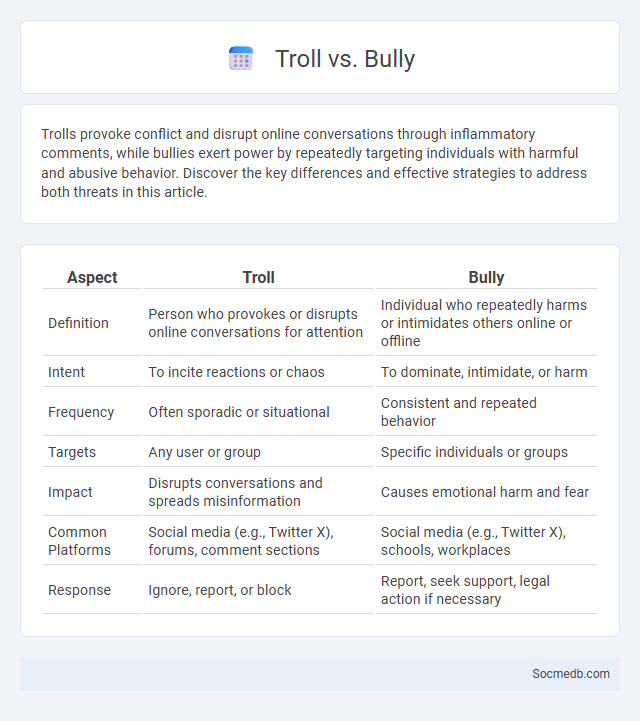
Photo illustration: Troll vs Bully
Trolls provoke conflict and disrupt online conversations through inflammatory comments, while bullies exert power by repeatedly targeting individuals with harmful and abusive behavior. Discover the key differences and effective strategies to address both threats in this article.
Table of Comparison
| Aspect | Troll | Bully |
|---|---|---|
| Definition | Person who provokes or disrupts online conversations for attention | Individual who repeatedly harms or intimidates others online or offline |
| Intent | To incite reactions or chaos | To dominate, intimidate, or harm |
| Frequency | Often sporadic or situational | Consistent and repeated behavior |
| Targets | Any user or group | Specific individuals or groups |
| Impact | Disrupts conversations and spreads misinformation | Causes emotional harm and fear |
| Common Platforms | Social media (e.g., Twitter X), forums, comment sections | Social media (e.g., Twitter X), schools, workplaces |
| Response | Ignore, report, or block | Report, seek support, legal action if necessary |
Defining Trolls: Characteristics and Behaviors
Trolls on social media exhibit behaviors such as deliberate provocation, spreading misinformation, and engaging in hostile interactions to elicit emotional responses from users. Characteristics of trolls include anonymity, persistence in disruptive comments, and targeting specific individuals or communities to create conflict. These actions contribute to toxic online environments, impacting user experience and community well-being.
Understanding Bullies: Key Traits
Understanding bullies involves recognizing key traits such as a need for control, lack of empathy, and a tendency to manipulate others on social media platforms. Bullies often exploit anonymity to spread harmful content, impacting Your emotional well-being and online experience. Identifying these behaviors early can help You develop effective strategies to protect Yourself and foster a safer digital environment.
Troll vs Bully: Semantic Differences
Trolls provoke conflict online by posting inflammatory or off-topic messages to elicit emotional reactions, while bullies repeatedly target individuals with harmful, abusive behavior intended to intimidate or cause lasting damage. Understanding this semantic difference helps you identify whether an online interaction is mere trolling or serious bullying, guiding your response and protecting your mental well-being. Recognizing the intent and frequency behind online attacks is essential for addressing issues on social media effectively.
Online Trolling: Motivations and Impact
Online trolling involves deliberate provocation or harassment to elicit emotional responses or disrupt conversations on social media platforms. Motivations for trolling include seeking attention, expressing frustration, or exerting control anonymously. The impact of trolling can lead to psychological distress, reduced online engagement, and a toxic environment that undermines community trust and meaningful discourse.
Bullying in Digital Spaces: Effects and Patterns
Bullying in digital spaces significantly impacts mental health, leading to increased anxiety, depression, and lowered self-esteem among victims. Patterns of cyberbullying often involve persistent harassment through social media platforms, anonymous messaging, and public shaming, which amplifies the victim's distress. Research highlights that early intervention and educational programs focused on digital literacy can help mitigate the harmful effects and break the cycle of online harassment.
Psychological Profiles: Trolls vs Bullies
Psychological profiles of social media users reveal distinct differences between trolls and bullies; trolls often seek attention and entertainment by provoking reactions through insincere or exaggerated comments, while bullies aim to harm or intimidate individuals directly with sustained personal attacks. Understanding these behaviors helps You recognize patterns to protect Your mental well-being against online harassment. Effective coping strategies include setting boundaries, reporting misuse, and fostering supportive digital communities.
Identifying Overlaps: When Trolls Become Bullies
Trolls and bullies on social media often share overlapping behaviors such as harassment, personal attacks, and spreading negativity, which amplify online toxicity. Recognizing these overlaps helps you address both issues more effectively by implementing targeted moderation strategies and support systems for victims. Understanding the blurred lines between trolling and bullying is crucial for creating safer digital communities.
Social Media Case Studies: Trolls and Bullies Compared
Social media case studies reveal distinct behaviors and impacts of trolls and bullies, highlighting trolls' intent to provoke reactions through inflammatory content, whereas bullies engage in targeted harassment causing significant psychological harm. Data from platforms like Twitter and Facebook demonstrate that troll activity often spikes during political events, while bullying cases are more prevalent among teenagers and young adults. Understanding these patterns aids in developing tailored moderation strategies and mental health interventions to reduce online harm.
Prevention and Response Strategies
Effective social media prevention and response strategies involve proactive monitoring of online platforms to identify potential threats or negative trends before they escalate. You should implement clear guidelines and training for staff to handle crises swiftly and maintain consistent, transparent communication with your audience. Leveraging tools such as sentiment analysis and real-time alerts enhances your ability to respond promptly and mitigate reputational damage.
Fostering Healthy Online Communities
Fostering healthy online communities requires active moderation to prevent harassment, misinformation, and toxic behavior while promoting respectful dialogue and inclusivity. Your participation in establishing clear guidelines and reporting harmful content strengthens trust and safety within social media platforms. Encouraging empathy and collaboration among users enhances the overall digital environment and mental well-being.
 socmedb.com
socmedb.com